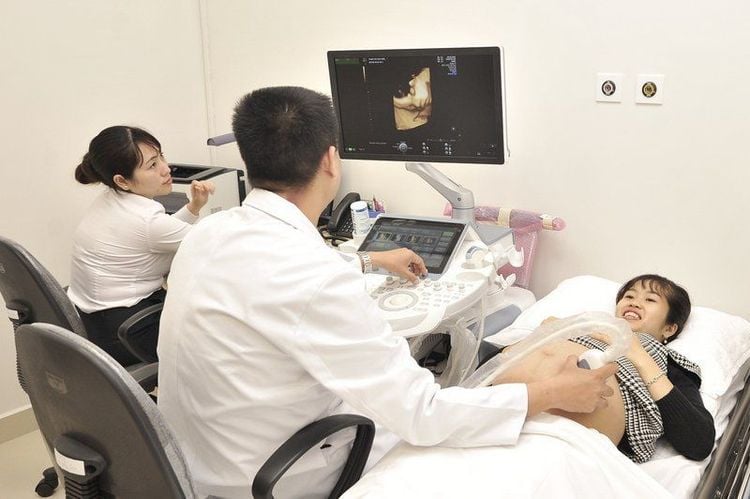This is an automatically translated article.
The article was professionally consulted by Specialist Doctor II Bui Thi Thu and Specialist Doctor II Tran Thi Mai Huong - Department of Obstetrics and Gynecology - Vinmec Hai Phong International General Hospital. These are two experienced doctors in Obstetrics and Gynecology with more than 25 years of work, with high expertise and strengths in the fields of: lower line surgery, laparoscopic surgery, difficult obstetric surgery.Obstetric induction is a procedure that induces uterine contractions before spontaneous labor occurs. Obstetric induction of labor is indicated when the potential benefits to the mother and baby outweigh the potential risks.
1. What is labor induction?
Induction of labor is the effect of uterine contractions, causing the uterus to open before spontaneous labor occurs. The purpose of induction of labor is for the baby to be born earlier, regardless of whether the water has broken or not.Changes of the cervix before the onset of labor include a softening, a shortening followed by the opening of the inner opening of the uterus. Before inducing labor, the doctor will evaluate the size of the mother's pelvis and cervix through the Bishop index. Then reassess the risks and benefits of induction. For the fetus, the doctor will determine the gestational age, estimate the fetal weight and determine the fetal position.
Failed induction of labor is when the uterus does not respond to stimulation or has abnormalities that endanger the mother and fetus, or after stimulation the cervix does not open.

2. When to induce labor?
Indications for induction of labor in obstetrics when:
Water has broken but not yet labored, membranes have broken but no uterine contractions or contractions are weak, amniotic fluid is depleted. Pregnancy past the date of birth. Maternal diseases such as: high blood pressure, pre-eclampsia, cancer requiring termination of pregnancy, heart disease without heart failure but premature rupture of membranes, autoimmune disease requiring termination of pregnancy. Amniotic fluid infection. The fetus has severe birth defects with indications for termination of pregnancy. Fetal death in utero. Intrauterine growth retardation. Induction of labor is contraindicated in the following cases:
Non-aggressive test and/or clinical manifestation test. Fetal-pelvic disproportion. Abnormal position has no indication for bottom line. Vegetable striker. Old cesarean scar on uterus with no indication for lower delivery. Umbilical cord prolapse (live fetus). Sexually transmitted diseases with indications for lower birth (genital herpes, genital warts). Severe chronic diseases of the mother such as heart failure, severe pre-eclampsia, eclampsia... (can be indicated by caesarean section).
3. Methods of inducing labor in obstetrics
3.1 Amniotic membrane separation Amniotic membrane separation is performed after vaginal examination, then the technician will insert his finger between the amniotic membrane and the cervix, the finger tip must be close to the cervix to separate the amniotic membrane from the cervix. cervical wall and lower uterine segment.
3.2 Amniocentesis Amniocentesis can only be performed when the cervix is dilated, by using a long needle or a Kocher stick to puncture the amniotic membrane, then using a finger to tear the amniotic membrane wide. Amniocentesis can be performed alone or in combination with oxytocin infusion. Assess the amount and color of amniotic fluid. Monitor fetal heart rate before and immediately after amniocentesis.

3.3 Induction of labor with a specialized balloon Induction of labor with Prostaglandin (only performed in a surgical facility)
PG E1: Not indicated for induction of labor in term and viable pregnant women because of the risk of rupture uterus and fetal distress. Other cases must be followed very closely. PG E2: Induce labor more smoothly and safely. Indicated for cases where vaginal delivery is possible, without old caesarean scar. 3.4 Amniocentesis combined with oxytocin infusion Amniocentesis combined with oxytocin infusion can only be performed at a surgical facility.
Steps include: Mix 5 units of oxytocin into 500 ml of 5% glucose solution, slow intravenous drip, initial dose of 5-8 drops/minute until uterine contractions appear. Amniocentesis, widening the amniotic membrane. Monitor and adjust the number of drops to achieve an appropriate number of contractions as labor progresses. In addition, depending on the situation of the delivery, if the contractions are quick, give oxytocin slow flow or it can be combined with tocolytic drugs that soften the cervix. A voluntary delivery is considered successful when contractions are regular, fetal heart rate is good, position is fully dilated and cervix is fully dilated, a vaginal delivery is possible, and the fetus is healthy. Note: For drugs that can inhibit the respiratory center of the fetus, it should only be used when the cervix has dilated at least 5-6 cm or more, the fetus is likely to pass and pass in a short time. .
Monitoring and dealing with complications: Monitoring:
Fetal heart rate; Uterine contractions; Cervical opening; The level of the throne to have a timely handling attitude. Management of complications:
If the fetus fails, the delivery must be stopped, surgery to save the pregnancy. If uterine contractions are too sparse or mild, increase the number of drops infusion. If too strong, quickly reduce the infusion flow and can be used to reduce uterine contractions. If the delivery lasts more than 6 hours and does not go well, a cesarean section is required. Possible complications are fetal failure or death due to poor follow-up and late intervention. May threaten rupture, uterine rupture due to oxytocin infusion causes rapid, strong contractions, at this time surgery is required to save mother and child. In summary, obstetric induction of labor is a procedure that causes uterine contractions to appear earlier so that a woman can give birth to a baby earlier than usual, when the baby or the mother has some health problems. There are many methods of inducing labor in obstetrics, including: separation of amniotic membranes, amniocentesis, induction of labor by balloon,...
However, induction of labor can leave many risks, so if the fetus develops If it develops normally, it is best to let labor happen naturally. If you or your baby has any other problems that need to be delivered early, you should immediately visit a health facility to be examined and evaluated the benefits of inducing labor compared with the potential risks.
At Vinmec International General Hospital, pregnant women will be examined and consulted carefully to detect early warning signs of fetal distress in the uterus. During labor, pregnant women will be monitored and cared for according to standard procedures and protocols, especially relatives will be allowed to enter the delivery room to accompany the mother. In addition, the clinic and delivery room are always fully equipped with fetal heart monitors and have an oxygen system available to immediately supply to the mother when needed.
Please dial HOTLINE for more information or register for an appointment HERE. Download MyVinmec app to make appointments faster and to manage your bookings easily.














